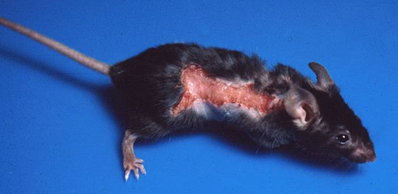
Etiology: There is no known cause of ulcerative dermatitis syndrome. The condition appears to be multifactorial, and may be associated with genetic factors, obsessive‐compulsive disorders, diet, environment, sex and age [4-6].
Incidence: The incidence of ulcerative dermatitis is common in C57BL/6 mice or strains with C57BL/6 background.
Clinical signs: C57BL/6 mice are prone to developing dermatitis with alopecia which often progresses to epidermal ulceration due to excessive scratching. Mice will repeatedly scratch along the head, neck, shoulders and axillary regions. Epidermal lesions are often colonized by opportunistic bacteria which can enhance irritation and cause an ongoing cycle of irritation and infection. With chronic conditions, the ulcerated areas can scar, causing contracture of skin and restriction of movement.
Pathology: Mice with ulcerative dermatitis develop focal ulcers with a mixed dermal inflammatory cell infiltrate consisting of neutrophils, macrophages, mast cells, and occasional lymphocytes. Adjacent epidermal hyperplasia can be observed [4, 5].
Diagnosis: The diagnosis can be made based on gross and histopathologic observation of the skin.
4. Sundberg, J.P., et al., Primary follicular dystrophy with scarring dermatitis in C57BL/6 mouse substrains resembles central centrifugal cicatricial alopecia in humans. Vet Pathol, 2011. 48(2): p. 513-24.
5. Kastenmayer, R.J., M.A. Fain, and K.A. Perdue, A retrospective study of idiopathic ulcerative dermatitis in mice with a C57BL/6 background. J Am Assoc Lab Anim Sci, 2006. 45(6): p. 8-12.
6. Duarte-Vogel, S.M. and G.W. Lawson, Association between hair-induced oronasal inflammation and ulcerative dermatitis in C57BL/6 mice. Comp Med, 2011. 61(1): p. 13-9.